Performance Evaluation of an Axial Flux Machine with a Hybrid Excitation Design
Abstract
:1. Introduction
2. Dual-Disc Axial Flux Machine Design with Hybrid Excitation Concept
3. Principle of Flux Control
4. Magnetic Flux Density Distribution and Back EMF Analysis
5. Electromagnetic Torque
6. Performance of FCAFPMM
7. Thermal Analysis
8. Conclusions
Author Contributions
Funding
Institutional Review Board Statement
Informed Consent Statement
Data Availability Statement
Conflicts of Interest
References
- Nedjar, B.; Hlioui, S.; Lecrivain, M.; Amara, Y.; Vido, L.; Gabsi, M. Study of a new hybrid excitation synchronous machine. In Proceedings of the XXth International Conference on Electrical Machines 2012, Marseille, France, 2–5 September 2012; pp. 2927–2932. [Google Scholar] [CrossRef]
- Gieras, J.F. PM synchronous generators with hybrid excitation systems and voltage control Capabilities: A review. In Proceedings of the XXth International Conference on Electrical Machines 2012, Marseille, France, 2–5 September 2012; pp. 2573–2579. [Google Scholar] [CrossRef]
- Wardach, M.; Palka, R.; Paplicki, P.; Prajzendanc, P.; Zarebski, T. Modern Hybrid Excited Electric Machines. Energies 2020, 13, 5910. [Google Scholar] [CrossRef]
- Geng, W.; Zhang, Z.; Jiang, K.; Yan, Y. A New Parallel Hybrid Excitation Machine: Permanent-Magnet/Variable-Reluctance Machine with Bidirectional Field-Regulating Capability. IEEE Trans. Ind. Electron. 2015, 62, 1372–1381. [Google Scholar] [CrossRef]
- Andrada, P.; Blanqué, B.; Martinez, E.; Torrent, M. A Novel Type of Hybrid Reluctance Motor Drive. IEEE Trans. Ind. Electron. 2014, 61, 4337–4345. [Google Scholar] [CrossRef]
- Zhao, W.; Shen, H.; Lipo, T.A.; Wang, X. A New Hybrid Permanent Magnet Synchronous Reluctance Machine with Axially Sandwiched Magnets for Performance Improvement. IEEE Trans. Energy Convers. 2018, 33, 2018–2029. [Google Scholar] [CrossRef]
- Zhao, X.; Niu, S.; Zhang, X.; Fu, W. Design of a New Relieving-DC-Saturation Hybrid Reluctance Machine for Fault-Tolerant In-Wheel Direct Drive. IEEE Trans. Ind. Electron. 2020, 67, 9571–9581. [Google Scholar] [CrossRef]
- Luo, X.; Lipo, T.A. A synchronous/permanent magnet hybrid AC machine. IEEE Trans. Energy Convers. 2000, 15, 203–210. [Google Scholar] [CrossRef] [Green Version]
- Xia, Y.; Yi, X.; Wen, Z.; Chen, Y.; Zhang, J. Direct Torque Control of Hybrid Excitation Permanent Magnet Synchronous Motor. In Proceedings of the 2019 22nd International Conference on Electrical Machines and Systems (ICEMS), Harbin, China, 11–14 August 2019; pp. 1–5. [Google Scholar] [CrossRef]
- Fodorean, D.; Djerdir, A.; Viorel, I.-A.; Miraoui, A. A Double Excited Synchronous Machine for Direct Drive Application—Design and Prototype Tests. IEEE Trans. Energy Convers. 2007, 22, 656–665. [Google Scholar] [CrossRef]
- Paplicki, P. Influence of Magnet and Flux-Barrier Arrange-ment on Flux Control Characteristics of Hybrid Excited ECPMS-machine. Elektron. Ir Elektrotechnika 2017, 23, 15–20. [Google Scholar] [CrossRef] [Green Version]
- Paplicki, P.; Palka, R.; Wardach, M.; Prajzendanc, P.; Mognaschi, M.E. Hybrid excited electric machine with axial flux bridges. Int. J. Appl. Electromagn. Mech. 2019, 59, 703–711. [Google Scholar] [CrossRef] [Green Version]
- May, H.; Meins, J.; Canders, W.R.; Pałka, R. New permanent magnet excited synchronous machine with extended, stator fixed auxilary excitation coil. In Proceedings of the XIV International Symposium on Electromagnetic Fields in Mechatronics, Electrical and Electronic Engineering, Arras, France, 10–12 September 2009. [Google Scholar]
- Liwen, L.; Hongmei, L.; Zhiwei, C.; Tian, Y.; Rundong, L.; Jingkui, M. Design of a Hybrid Excited Permanent Magnet Machine with AC Field Winding Excitation. In Proceedings of the 22nd International Conference on Electrical Machines and Systems (ICEMS), Harbin, China, 11–14 August 2019; pp. 1–4. [Google Scholar] [CrossRef]
- Gao, Y.; Li, D.; Qu, R.; Fan, X.; Li, J.; Ding, H. A Novel Hybrid Excitation Flux Reversal Machine for Electric Vehicle Propulsion. IEEE Trans. Veh. Technol. 2018, 67, 171–182. [Google Scholar] [CrossRef]
- Wardach, M.; Bonislawski, M.; Palka, R.; Paplicki, P.; Prajzendanc, P. Hybrid Excited Synchronous Machine with Wireless Supply Control System. Energies 2019, 12, 3153. [Google Scholar] [CrossRef] [Green Version]
- Aydin, M.; Huang, S.; Lipo, T.A. Design, Analysis, and Control of a Hybrid Field-Controlled Axial-Flux Permanent-Magnet Motor. IEEE Trans. Ind. Electron. 2010, 57, 78–87. [Google Scholar] [CrossRef]
- Capponi, F.G.; De Donato, G.; Borocci, G.; Caricchi, F. Axial-Flux Hybrid-Excitation Synchronous Machine: Analysis, Design, and Experimental Evaluation. IEEE Trans. Ind. Appl. 2014, 50, 3173–3184. [Google Scholar] [CrossRef]
- Ostroverkhov, M.; Chumack, V.; Monakhov, E. Synchronous Axial-Flux Generator with Hybrid Excitation in Stand Alone Mode. In Proceedings of the 2019 IEEE 2nd Ukraine Conference on Electrical and Computer Engineering (UKRCON), Lviv, Ukraine, 2–6 July 2019; pp. 455–459. [Google Scholar]
- Chen, Z.; Zhou, N. Flux regulation ability of a hybrid excitation doubly salient machine. IET Electr. Power Appl. 2011, 5, 224–229. [Google Scholar] [CrossRef]
- Hou, J.; Geng, W.; Zhu, T.; Li, Q. Topological Principle and Electromagnetic Performance of a Novel Axial-Flux Hybrid-Excitation In-wheel Motor. In Proceedings of the 23rd European Conference on Power Electronics and Applications (EPE’21 ECCE Europe) 2021, Ghent, Belgium, 6–10 September 2021; pp. 1–8. [Google Scholar]
- Geng, W.; Zhang, Z.; Li, Q. Concept and Electromagnetic Design of a New Axial Flux Hybrid Excitation Motor for In-wheel Motor Driven Electric Vehicle. In Proceedings of the 2019 22nd International Conference on Electrical Machines and Systems (ICEMS), Harbin, China, 11–14 August 2019; pp. 1–6. [Google Scholar] [CrossRef]
- Hsu, J. Direct control of air-gap flux in permanent-magnet machines. IEEE Trans. Energy Convers. 2000, 15, 361–365. [Google Scholar] [CrossRef]
- Paplicki, P.; Prajzendanc, P. The influence of permanent magnet length and magnet type on flux-control of axial flux hybrid excited electrical machine. In Proceedings of the 14th Selected Issues of Electrical Engineering and Electronics (WZEE), Szczecin, Poland, 19–21 November 2018; pp. 1–4. [Google Scholar] [CrossRef]
- Paplicki, P.; Prajzendanc, P.; Wardach, M.; Palka, R.; Cierzniewski, K.; Pstrokonski, R. Influence of Geometry of Iron Poles on the Cogging Torque of a Field Control Axial Flux Permanent Magnet Machine. Int. J. Appl. Electromagn. Mech. 2022, 1–5, in press. [Google Scholar]



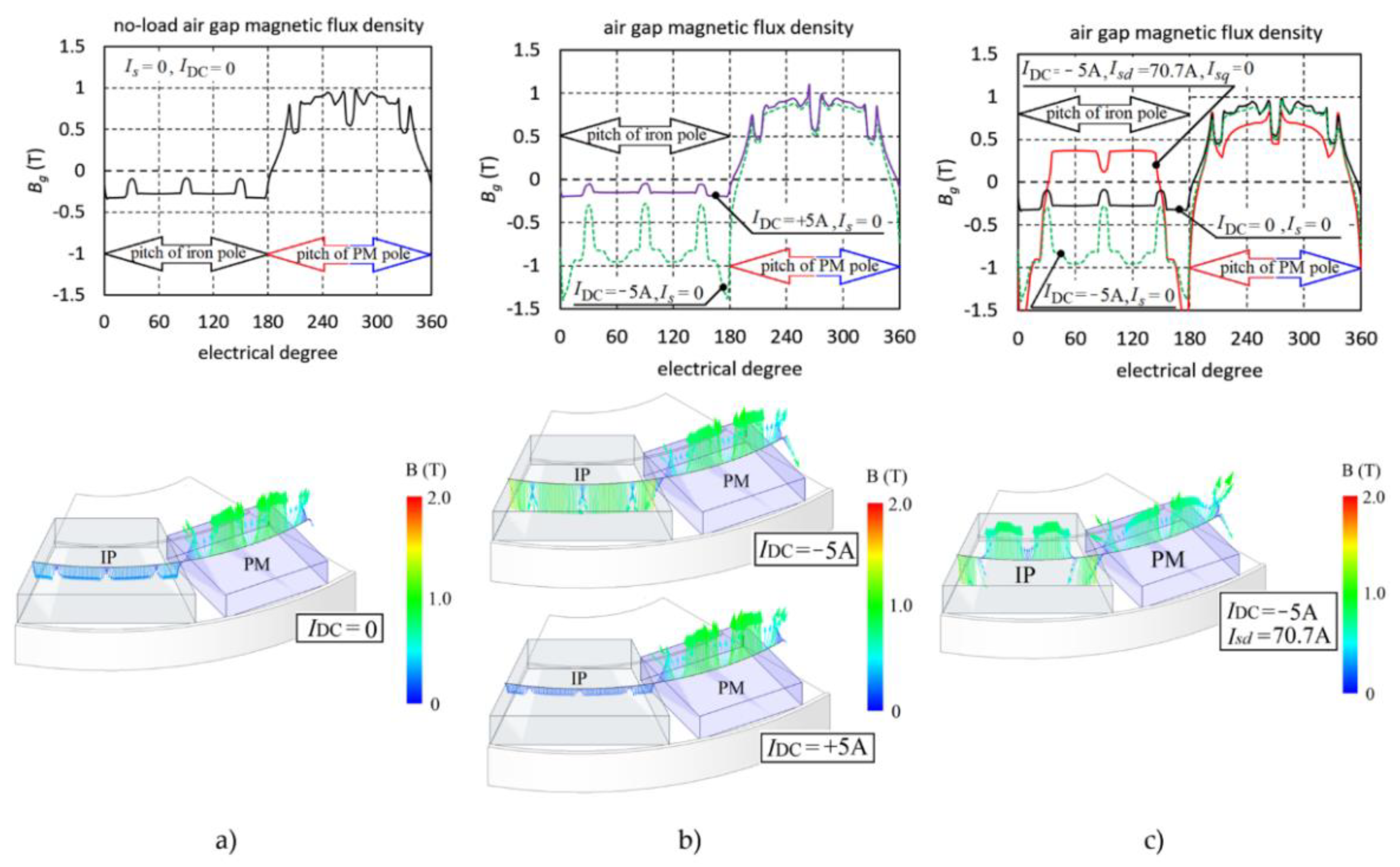



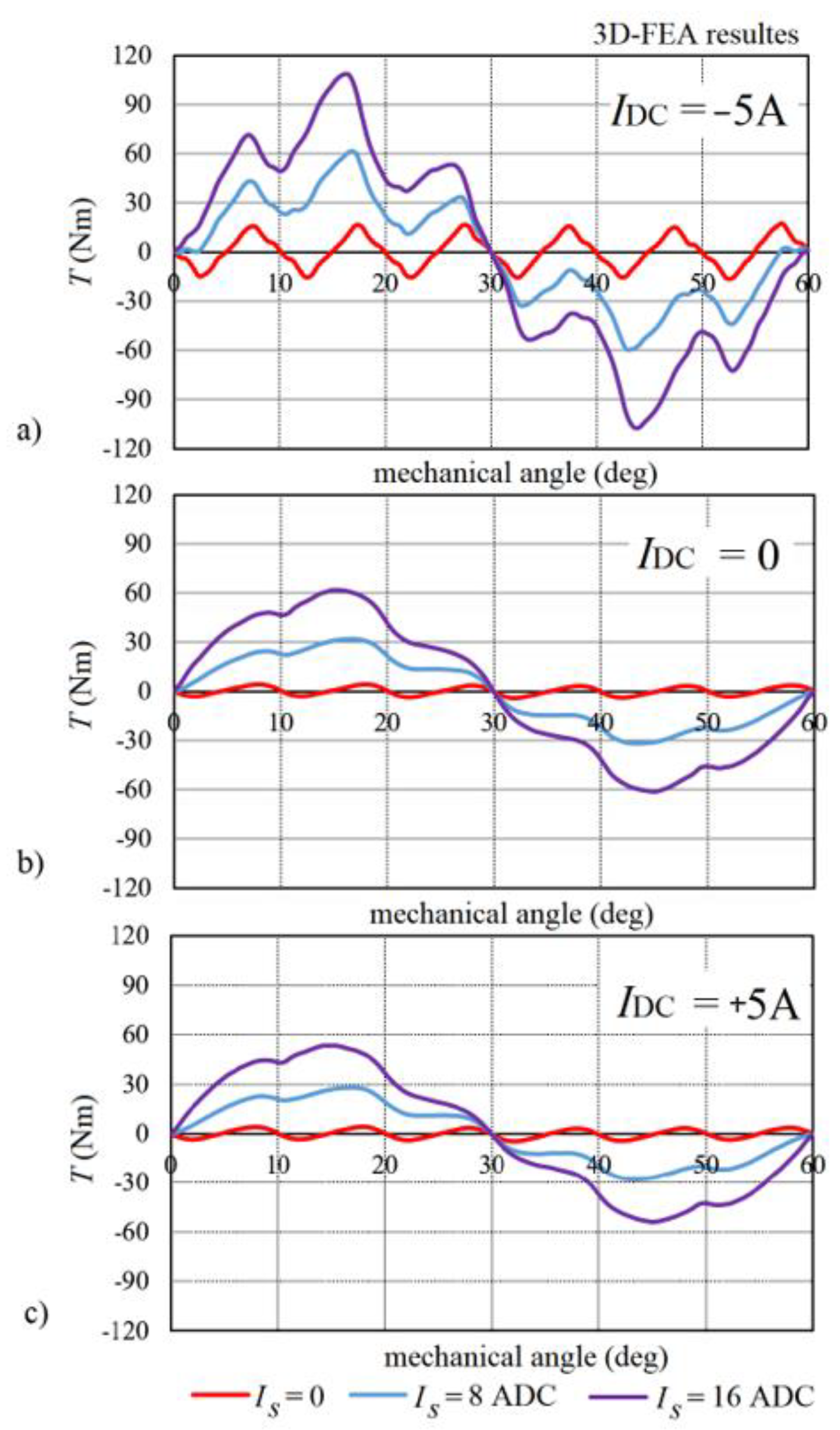
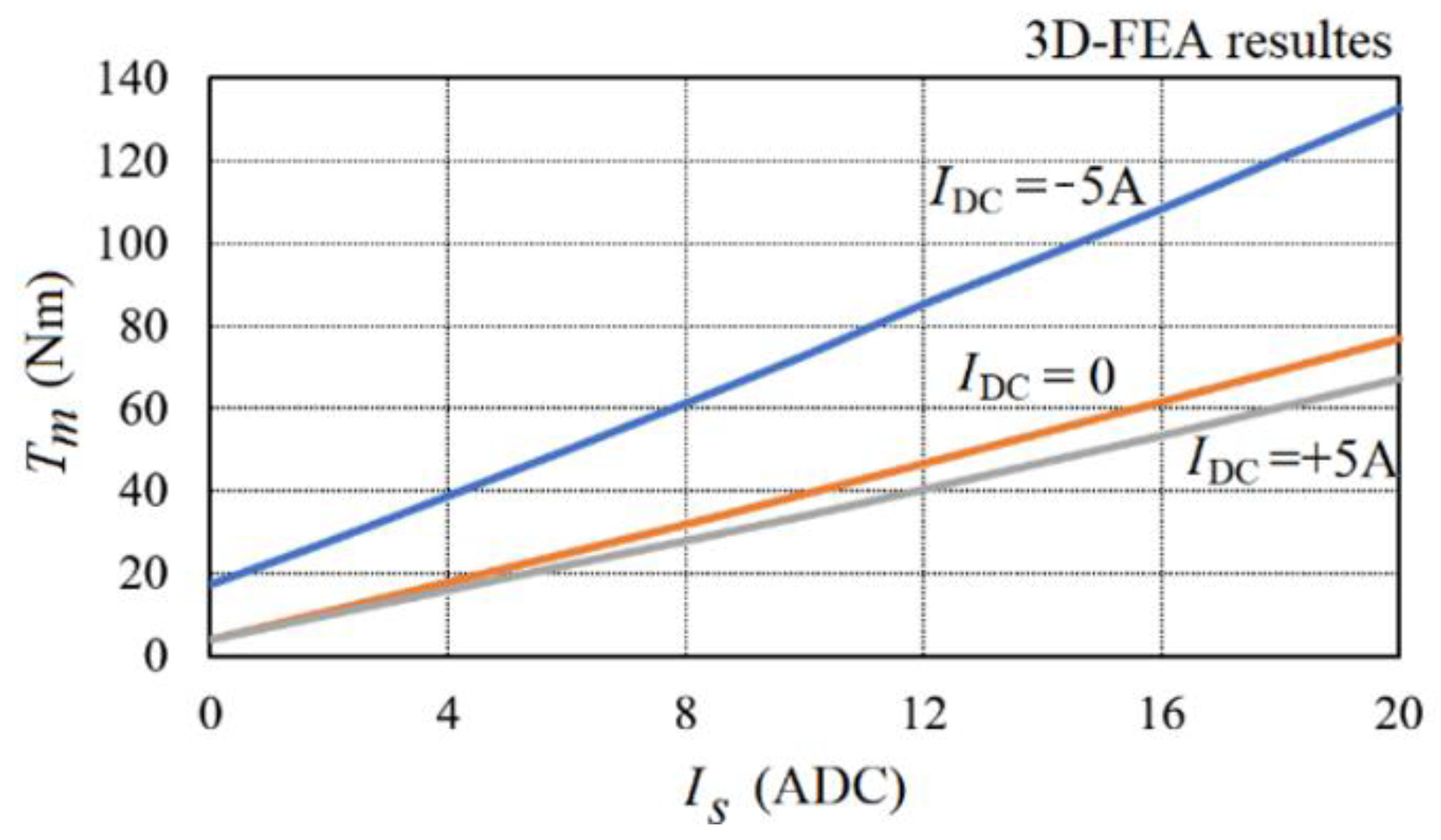

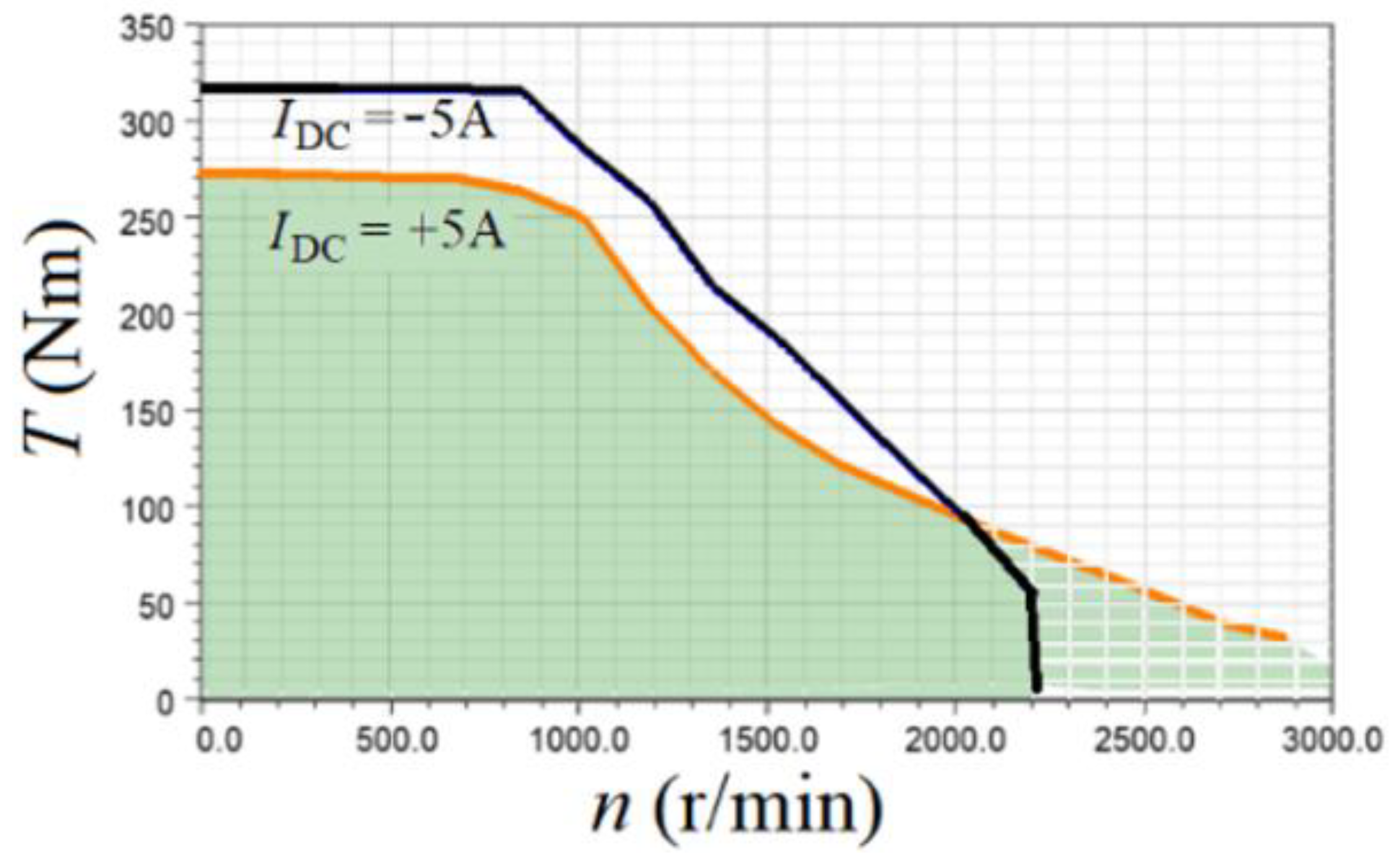
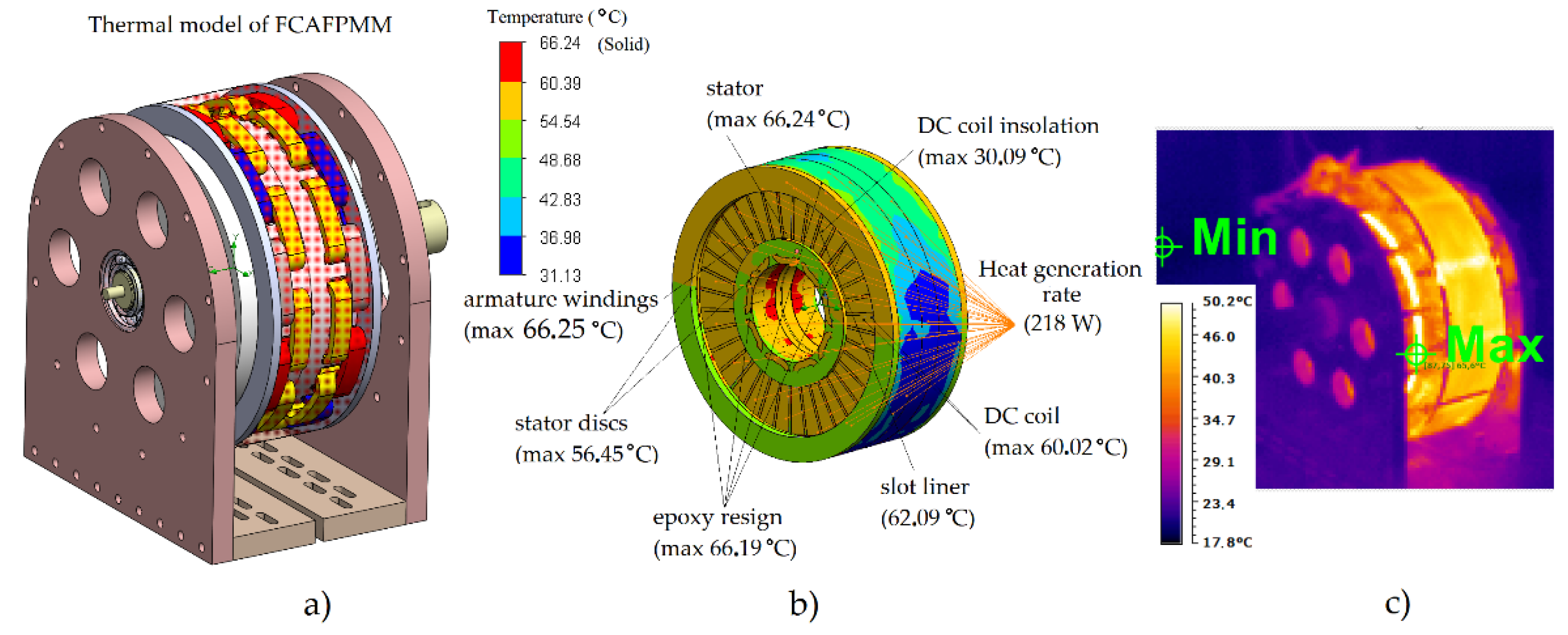

Publisher’s Note: MDPI stays neutral with regard to jurisdictional claims in published maps and institutional affiliations. |
© 2022 by the authors. Licensee MDPI, Basel, Switzerland. This article is an open access article distributed under the terms and conditions of the Creative Commons Attribution (CC BY) license (https://creativecommons.org/licenses/by/4.0/).
Share and Cite
Prajzendanc, P.; Paplicki, P. Performance Evaluation of an Axial Flux Machine with a Hybrid Excitation Design. Energies 2022, 15, 2733. https://doi.org/10.3390/en15082733
Prajzendanc P, Paplicki P. Performance Evaluation of an Axial Flux Machine with a Hybrid Excitation Design. Energies. 2022; 15(8):2733. https://doi.org/10.3390/en15082733
Chicago/Turabian StylePrajzendanc, Pawel, and Piotr Paplicki. 2022. "Performance Evaluation of an Axial Flux Machine with a Hybrid Excitation Design" Energies 15, no. 8: 2733. https://doi.org/10.3390/en15082733
APA StylePrajzendanc, P., & Paplicki, P. (2022). Performance Evaluation of an Axial Flux Machine with a Hybrid Excitation Design. Energies, 15(8), 2733. https://doi.org/10.3390/en15082733






